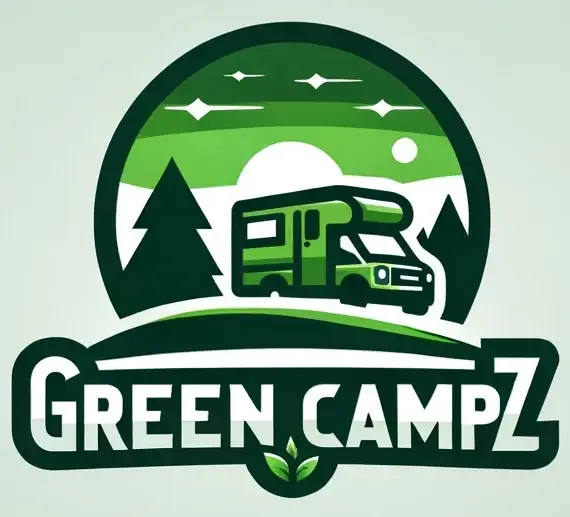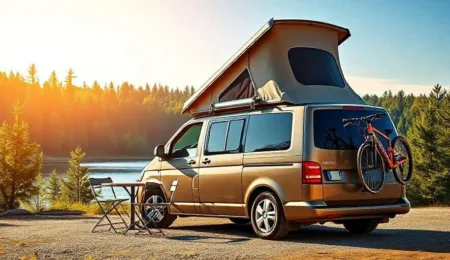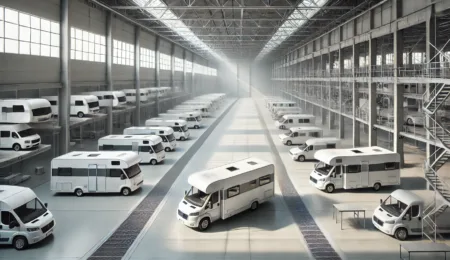First caravan, motorhome or campervan: Your Guide to start!
Caravaning has become increasingly popular in Spain, offering a unique way to explore the country’s diverse landscapes. Many people choose motorhomes, caravans, and campers for their flexibility and comfort while traveling.
This article covers various aspects of caravaning in Spain. It will discuss types of vehicles, renting versus buying, popular routes, preparation tips, and legal considerations for a successful journey.

Exploring Caravaning in Spain
Caravaning has become a popular choice for travel enthusiasts in Spain. This section delves into the rise of caravaning and its cultural impact across the country.
The Rise of Caravaning
In recent years, the phenomenon of caravaning has witnessed substantial growth in Spain. This surge is attributed to various factors, including a growing desire for outdoor experiences and the need for safe travel alternatives that allow for social distancing. The appeal of having a mobile home equipped with all essential amenities has led to many families and individuals opting for this mode of travel.
Data suggests that the number of registered motorhomes and caravans has increased significantly. This trend shows that more people appreciate the freedom and flexibility that caravaning provides. These vehicles enable adventurers to explore Spain’s diverse landscapes, from breathtaking coastal routes to picturesque mountain trails.
Cultural Impact
Caravaning has not only changed how Spaniards travel but also influenced the culture around it. Communities of travelers have formed, creating a vibrant culture that cherishes shared experiences and discovery. Various forums and social media groups are dedicated to exchange tips, recommend destinations, and share stories, enriching the caravaning experience for many.
This cultural shift is also evident in local economies, particularly in rural areas. Many small businesses and local attractions have recognized the influx of caravaners and adapted their services to cater to this demographic. Campgrounds, for example, are increasingly investing in special facilities and amenities aimed at welcoming motorhome travelers.
- Growth of local economies through caravan tourism.
- Formation of partnerships with local producers and artisans.
- Emergence of caravan-specific events and gatherings.
Furthermore, caravaning encourages a closer relationship with nature. People are more inclined to explore natural parks and scenic locations, fostering an appreciation for Spain’s rich biodiversity. This connection to nature not only enhances their travel experience but also sparks a collective interest in preserving the environment for future generations.
As the caravaning culture continues to grow, so does the emphasis on sustainable practices. Many travelers are becoming more conscious of their environmental footprint, seeking eco-friendly solutions such as solar energy systems and water recycling mechanisms in their vehicles. This shift highlights the caravaning community’s commitment to enjoying nature while being responsible stewards of the environment.
Types of Vehicles for Travel
When embarking on an adventure through Spain, selecting the right vehicle is crucial. Different types of vehicles cater to varying needs and preferences. Understanding the specifics of motorhomes, caravans, and campers will help maximize the travel experience.
Motorhomes Explained
Motorhomes are integrated vehicles that combine both transportation and living space. They come in various designs, making them suitable for a wide range of travelers. Their self-sufficiency and comprehensive features appeal to many.
Advantages of Motorhomes
- All-in-One Convenience: Motorhomes offer a compact solution for traveling, allowing families and groups to stay, cook, and travel in one vehicle.
- Autonomy: With a motorhome, it is easier to stop at scenic locations and stay overnight, providing a sense of freedom.
- Comfort: Many models come equipped with amenities such as showers, kitchens, and spacious sleeping arrangements, mimicking the comforts of home.
- Ease of Driving: Motorhomes are built for the road, designed for comfortable driving experiences compared to towing a caravan.
Disadvantages of Motorhomes
- Space Limitations: While spacious, motorhomes can sometimes be cramped for larger groups or longer journeys.
- Fuel Consumption: Larger motorhomes can be less fuel-efficient, resulting in higher travel costs.
- Maintenance Costs: Regular servicing and potential repairs can be more expensive compared to simpler vehicles.
Understanding Caravans
Caravans are towable living units that separate the driving experience from the living space. They require a suitable vehicle for towing, which allows for more flexibility when stopping and setting up camp.
Pros of Caravans
- Roominess: Caravans typically provide more living space than motorhomes, which benefits families or groups needing extra room.
- Flexibility: You can unhitch the caravan to explore destinations with just the towing vehicle, making it easier to navigate through narrow streets or urban areas.
- Variety of Models: Caravans come in various sizes and styles, allowing you to choose one that fits specific camping needs.
Cons of Caravans
- Towing Challenges: Towing a caravan requires skill and can be intimidating for less experienced drivers, especially in hilly or winding terrains.
- Setup Time: Setting up a caravan at a campsite can take more time and effort compared to parking a motorhome.
- Storage Requirements: Caravans require suitable parking space and maintenance when not in use, which may be a consideration for owners.
The Versatility of Campers
Campers, often based on vans, are compact and offer flexibility for travel. They are suitable for spontaneous trips and can navigate tighter spaces more easily than larger motorhomes or caravans.
Benefits of Campers
- Compact Size: Campers are easier to drive and park, particularly in urban settings, making them practical for short excursions.
- Quick Setup: The minimalist approach allows for fast setup at campgrounds, enhancing the travel experience.
- Cost-Effective: Generally, campers are more affordable to buy and maintain compared to larger motorhomes and caravans.
Limitations of Campers
- Space Constraints: The compact design may not offer enough room for larger families or extended trips.
- Less Equipped: Many campers have fewer amenities than motorhomes, possibly sacrificing comfort on longer journeys.
- Storage Limitations: Limited internal storage can be an issue, necessitating careful packing for trips.
Renting vs Buying: What to Consider
When deciding between renting and buying a vehicle for caravanning, several factors must be evaluated. Each option offers distinct advantages and challenges that affect the travel experience.
Renting a Vehicle
Renting a vehicle provides flexibility and convenience, making it an appealing choice for many travelers. This option allows individuals to enjoy a temporary lifestyle on the road without the long-term commitment of ownership.
Pros and Cons
Renting has both benefits and drawbacks that deserve consideration:
- Pros:
- Lower initial costs, as there is no substantial investment needed upfront.
- The opportunity to try different models and types of vehicles without commitment.
- Maintenance and repairs are typically covered by rental companies, alleviating potential hassles.
- Flexibility to rent for specific trips, eliminating the need for storage when not in use.
- Cons:
- Rental fees can accumulate quickly, especially for extended trips.
- Limited customization options, as the vehicle must be returned in the original condition.
- Potential restrictions on mileage or travel locations set by rental agreements.
Insurance and Coverage
Understanding insurance options is crucial when renting a vehicle. Most rental companies provide insurance, but it is essential to review the policy details. Coverage typically includes:
- Collision damage waiver, protecting against damage to the rented vehicle.
- Liability coverage to protect against third-party claims during the rental period.
- Personal accident insurance for medical expenses incurred by the driver and passengers.
Travelers may also opt for additional coverage through their own insurance providers or credit cards, so evaluating existing policies is important before renting.
Purchasing Options
For those looking to invest in a vehicle, purchasing offers a long-term solution for caravanning enthusiasts. Owning a vehicle brings the benefit of not having to adhere to rental agreements and the freedom to travel whenever desired.
New Models
Acquiring a new vehicle ensures access to the latest features, technology, and warranties. New models often come equipped with modern amenities that enhance comfort and convenience. Buyers can customize the vehicle to suit their travel preferences and needs. However, the initial expense can be significant, and buyers should consider the ongoing costs of insurance, maintenance, and storage when budgeting for a new model.
Second-Hand Deals
Second-hand vehicles can represent a more affordable entry into the caravanning lifestyle. This option allows buyers to find a variety of models that may suit their budget. When considering a second-hand purchase, it is vital to:
- Inspect the vehicle thoroughly to assess its condition and history.
- Review service records to ensure proper maintenance has been performed.
- Consider purchasing from reputable dealers who provide warranties or guarantee the condition of the vehicle.
While second-hand vehicles typically have lower upfront costs, potential buyers should factor in any upcoming maintenance or repairs that might be necessary, especially if the vehicle is older.
Popular Routes and Destinations
Spain offers an array of breathtaking routes and destinations perfect for exploration with a motorhome, caravan, or camper. From the lush landscapes of the north to the sun-drenched charms of the south, there’s something for every adventurer.
Scenic Routes in the North
The northern regions of Spain boast stunning landscapes, rich cultures, and delicious gastronomy. Travelling through these scenic routes allows for a unique experience filled with picturesque villages and natural wonders.
The Basque Country
The Basque Country, with its dramatic coastline and lush green hills, is a must-visit destination. Here are some highlights:
- San Sebastián: Known for its beautiful beaches and vibrant culinary scene.
- Bilbao: Home to the iconic Guggenheim Museum, blending modern architecture with traditional Basque culture.
- Bioparc: A zoo that immerses visitors in the natural habitats of the animals.
This region offers various unsung trails that meander through the countryside, making it an ideal setting for peaceful stops or overnight stays in breathtaking locations.
Galicia’s Coastline
Galicia’s dramatic coastline is famous for its rugged cliffs and stunning beaches. This region provides the perfect backdrop for those seeking both adventure and tranquillity. Notable sites include:
- Rías Baixas: A series of estuaries renowned for their beautiful beaches and delicious seafood.
- Santiago de Compostela: A historic city known for its pilgrim routes and stunning cathedral.
- A Guarda: Featuring the breathtaking Monte de Santa Trega and views of the Atlantic Ocean.
Galicia’s coastal routes, with their scenic viewpoints and traditional villages, invite exploration and relaxation.
Southern Adventures
The southern regions of Spain offer vibrant culture, historical landmarks, and beautiful landscapes. A jaunt here reveals hidden gems and captivating experiences.
Andalusia’s Hidden Gems
Andalusia is famed for its rich history, stunning architecture, and gorgeous landscapes. Among its hidden gems are:
- Ronda: A picturesque town set high above a deep gorge, ideal for breathtaking views and historical sites.
- Córdoba: Known for the remarkable Mezquita, this city offers a peek into the rich cultural fusion of its past.
- Granada: A city crowned by the majestic Alhambra, with stunning gardens and incredible architecture.
Traveling through Andalusia presents opportunities to sample delicious regional cuisine and immerse oneself in its lively traditions.
Exploring Antequera
Located in the heart of Andalusia, Antequera is a destination rich in history and surrounded by beautiful landscapes. Key attractions include:
- Antequera Dolmens: A UNESCO World Heritage site showcasing prehistoric burial sites.
- El Torcal de Antequera: A natural park with unique limestone formations and stunning hiking trails.
- La Alcazaba: A historic fortress offering panoramic views of the region.
This enchanting town serves as a perfect base for exploring the surrounding rural landscapes, adding a cultural touch to any camping trip.
Preparing for Your Journey
Preparation is key to ensuring a smooth and enjoyable journey in a motorhome or camper. Being well-equipped helps avoid unexpected challenges and enhances the overall experience while travelling.
Essential Supplies
Food and Water
Having adequate food and water is crucial for any trip. It is recommended to carry a mix of non-perishable items and fresh produce. Some staple foods to consider include:
- Rice and pasta
- Canned vegetables and beans
- Dried fruits and nuts
- Snacks like crackers and granola bars
- Condiments and spices for flavouring
Fresh water should be stored in clean containers to ensure safety. While most campsites provide water access points, it is wise to carry enough for the journey between stops. Water filters or purification tablets can be useful if filling up from non-potable sources.
Camping Equipment
The right camping equipment enhances comfort and convenience during the journey. Essential items include:
- Tent or awning for extra shade and space
- Sleeping bags and inflatable mattresses for restful nights
- Cooking equipment, such as portable stoves and utensils
- Camping chairs and tables for outdoor meals
- Lighting sources like lanterns and headlamps for nighttime visibility
It is advisable to pack tools for minor repairs, as well as outdoor gear suitable for various weather conditions, to ensure preparedness for unexpected scenarios.
Vehicle Maintenance Tips
Routine Checks
Prior to embarking on a journey, conducting routine checks on the vehicle is essential. Important aspects to inspect include:
- Fluid levels, including oil and coolant
- Tire pressure and tread conditions
- Brake functionality and battery status
- Lights and signals to ensure proper visibility
- Wipers and windows for clear sightlines
Regular maintenance not only promotes safety but also extends the life of the vehicle. Keeping service records up to date can help in tracking needed repairs or replacements over time.
Emergency Kits
An emergency kit is a vital component of trip preparedness. Essential items to include in an emergency kit are:
- First aid supplies such as bandages, antiseptics, and pain relievers
- Basic tools like wrenches and screwdrivers for quick fixes
- A flashlight with extra batteries for power outages or nighttime use
- Emergency blankets to retain warmth
- Non-perishable food items and water in case of unforeseen delays
Ensuring that an emergency kit is easily accessible and regularly checked for expired items is crucial in preparing for unexpected situations while on the road.
Legal Considerations and Best Practices
Understanding the legal landscape is essential for a hassle-free journey in Spain with motorhomes, caravans, and campers. Abiding by local regulations ensures safety and enhances the travel experience.
Understanding Parking Regulations
Parking regulations vary significantly across different regions in Spain. It is vital to familiarize oneself with local laws to avoid fines and ensure safe parking. In some cities, parking restrictions may be enforced to preserve public spaces and maintain traffic flow. The following guidelines are useful:
- Check for dedicated motorhome parking areas, which can often be found near campgrounds or designated rest stops.
- Pay attention to local signage indicating parking restrictions, including time limits and prohibitions specific to larger vehicles.
- Some regions may have specific rules about overnight parking. Research these limitations ahead of time to avoid unwanted surprises.
- Utilize applications and websites that provide up-to-date information on parking regulations and available spots for caravans and motorhomes.
Safety and Compliance Tips
Ensuring compliance with safety regulations not only enhances the driving experience but also safeguards all passengers. Understanding local laws and practices concerning the operation of motorhomes, caravans, and campers is crucial. Here are some key compliance factors to consider:
- Always wear seatbelts while the vehicle is in motion. Ensure that all passengers are secured in their seats before starting the journey.
- Familiarize oneself with speed limits, which can differ for larger vehicles. Generally, motorhomes and caravans have lower speed limits than standard cars.
- Ensure that the vehicle is properly registered and that all necessary documentation, such as insurance and road tax, is up to date.
- Review the laws about carrying pets in the vehicle. Ensure that animals are safely secured in accordance with local regulations.
- Know the legal requirements for waste disposal. Many campsites provide facilities for emptying waste tanks, so use these services to maintain a clean environment.
- Always have an emergency kit on hand, including items such as a first-aid kit, flashlight, and basic tools. This preparation can be invaluable if issues arise on the road.





Leave a Reply